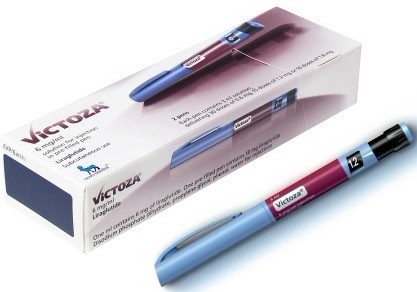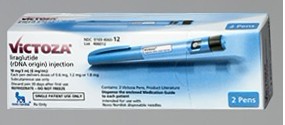英文药名: Victoza Pre Filled Pen Injection(Liraglutide)
中文药名: 利拉鲁肽预充注射笔
生产厂家: Novo Nordisk Pharmaceuticals
药品介绍
美国食品药品管理局(FDA)近日批准Victoza (liraglutide,利拉鲁肽)注射剂用于部分成年患者2型糖尿病的治疗。Victoza属胰高血糖素样肽1(GLP-1)类似物药物(注射剂,每日注射一次),能够在患者进食后促使其胰腺分泌更多胰岛素,对于没有进行适当的饮食控制和运动的患者,Victoza不被推荐单独用于糖尿病的初期治疗。
FDA药品审评与研究中心新陈代谢与内分泌室主任、医学博士Mary Parks说,“糖尿病是引起死亡和致残的一个主要原因,每年新诊断出的糖尿病患者超过了1500万人。对于预防或控制长期的糖尿病并发症来看,控制血糖水平是非常重要的,Victoza为部分2型糖尿病患者提供了控制血糖水平的备选方案。”
Victoza最常见的不良反应包括头痛、恶心和腹泻。其他不良反应包括荨麻疹等过敏样反应。有3900位患者参加的5个临床试验结果显示,使用Victoza的患者发生胰腺炎(胰腺的一种炎症)的可能性要大于使用其他治疗药物的患者。当患者出现严重腹痛,伴随或未伴随恶心、呕吐时,应停止使用Victoza,当确诊为胰腺炎后,不应再次使用Victoza进行治疗。有胰腺炎病史的患者应慎用。动物试验显示,Victoza会引起大鼠和小鼠出现甲状腺瘤。因此,尚不能确认是否会引起人甲状腺瘤或癌,为此,在继续进行研究以证明可以扩大使用之前,Victoza不能作为治疗2型糖尿病的一线药物,也不能用于治疗已患甲状腺髓样癌的患者。
诺和诺德公司于2009年7月8日宣布,欧洲药品管理局(EMEA)人用药品委员会(CHMP)表决通过了对Victoza®的积极评价,建议颁发入市许可,将该药用于治疗2型糖尿病。
Victoza®是利拉鲁肽的商标名,它是第一个人胰高糖素样肽-1(GLP-1)类似物,每日皮下注射一次,用于治疗2型糖尿病。对Victoza®的积极评价包括:
1、对于单独服用最大剂量的二甲双胍或磺脲类药物仍不能控制血糖的患者来说,Victoza®与二甲双胍或者与磺脲类药物联合使用,可改善血糖控制;
2、对于即使采用“二甲双胍+磺脲类药物”或“二甲双胍+噻唑烷二酮”联合治疗也不能控制血糖的患者来说,Victoza®与“二甲双胍+磺脲类药物”或者与“二甲双胍+噻唑烷二酮”联合使用,可进一步改善血糖控制。
诺和诺德公司有望在大约两个月以内收到欧盟委员会正式颁发的入市许可。得到欧盟委员会批准以后,诺和诺德公司打算今年夏季在一些欧洲国家的市场上开始销售Victoza®。
“CHMP的积极评价令人高兴,我们相信欧洲的很多2型糖尿病患者将很快得到Victoza®,” 诺和诺德公司执行副总裁兼首席科学官Mads Krogsgaard Thomsen说。“对6500多位患者的临床研究表明,Victoza®可显著降低血糖和体重,而发生低血糖症的风险却很小。由此看来,我们确信Victoza®是2型糖尿病患者可以选择的一种很有价值的新药。”
1月29日诺和诺德公司公布了2008年财务业绩和2009年财务业绩预测;目前,这一预测尚未因CHMP的积极评价而改变。诺和诺德公司将于2009年4月30日公布今年第一季度的财务数据,届时将对2009年的财务业绩预测数据做出更新。
*关于Victoza®
Victoza®是第一个人胰高糖素样肽-1(GLP-1)类似物,每日皮下注射一次,用于治疗2型糖尿病。患者血糖水平过高时,Victoza®可刺激胰岛素的分泌,降低食欲。2008年5月23日,诺和诺德公司向美国食品药品管理局提交了新药申请,向欧洲药品管理局提交了入市申请,请求他们批准将Victoza®用于治疗2型糖尿病。2008年7月14日还向日本有关当局提交了新药申请。
 |
Victoza® was evaluated in a 52-week monotherapy trial and in five 26-week, add-on combination trials.
GLP-1 (7-37) represents <20% of total circulating endogenous GLP-1.
Crossix ScoreBoard™ Report, March 2011. Adherence measured by number of actual Victoza® prescriptions filled for existing Victoza® patients enrolled in VictozaCare™ versus a match-pair control group not enrolled in VictozaCare™ through first 8 months of enrollment.
Indications and Usage
Victoza® is indicated as an adjunct to diet and exercise to improve glycemic control in adults with type 2 diabetes mellitus.
Because of the uncertain relevance of the rodent thyroid C-cell tumor findings to humans, prescribe Victoza® only to patients for whom the potential benefits are considered to outweigh the potential risk. Victoza® is not recommended as first-line therapy for patients who have inadequate glycemic control on diet and exercise.
In clinical trials of Victoza®, there were more cases of pancreatitis with Victoza® than with comparators. Victoza® has not been studied sufficiently in patients with a history of pancreatitis to determine whether these patients are at increased risk for pancreatitis while using Victoza®. Use with caution in patients with a history of pancreatitis.
Victoza® is not a substitute for insulin. Victoza® should not be used in patients with type 1 diabetes mellitus or for the treatment of diabetic ketoacidosis, as it would not be effective in these settings.
The concurrent use of Victoza® and insulin has not been studied.
Important Safety Information
Liraglutide causes dose-dependent and treatment-duration-dependent thyroid C-cell tumors at clinically relevant exposures in both genders of rats and mice. It is unknown whether Victoza® causes thyroid C-cell tumors, including medullary thyroid carcinoma (MTC), in humans, as human relevance could not be ruled out by clinical or nonclinical studies. Victoza® is contraindicated in patients with a personal or family history of MTC and in patients with Multiple Endocrine Neoplasia syndrome type 2 (MEN 2). Based on the findings in rodents, monitoring with serum calcitonin or thyroid ultrasound was performed during clinical trials, but this may have increased the number of unnecessary thyroid surgeries. It is unknown whether monitoring with serum calcitonin or thyroid ultrasound will mitigate human risk of thyroid C-cell tumors. Patients should be counseled regarding the risk and symptoms of thyroid tumors.
If pancreatitis is suspected, Victoza® should be discontinued. Victoza® should not be re-initiated if pancreatitis is confirmed.
When Victoza® is used with an insulin secretagogue (e.g. a sulfonylurea) serious hypoglycemia can occur. Consider lowering the dose of the insulin secretagogue to reduce the risk of hypoglycemia.
Renal impairment has been reported postmarketing, usually in association with nausea, vomiting, diarrhea, or dehydration which may sometimes require hemodialysis. Use caution when initiating or escalating doses of Victoza® in patients with renal impairment.
There have been no studies establishing conclusive evidence of macrovascular risk reduction with Victoza® or any other antidiabetic drug.
The most common adverse reactions, reported in ≥5% of patients treated with Victoza® and more commonly than in patients treated with placebo, are headache, nausea, diarrhea, and anti-liraglutide antibody formation. Immunogenicity-related events, including urticaria, were more common among Victoza®-treated patients (0.8%) than among comparator-treated patients (0.4%) in clinical trials.
Victoza® has not been studied in type 2 diabetes patients below 18 years of age and is not recommended for use in pediatric patients.
Victoza® should be used with caution in patients with hepatic impairment.
Counsel patients regarding the risk for MTC and the symptoms of thyroid tumors (e.g. a mass in the neck, dysphagia, dyspnea, or persistent hoarseness).
Patients with thyroid nodules noted on physical examination or neck imaging obtained for other reasons should be referred to an endocrinologist for further evaluation.
Although routine monitoring of serum calcitonin is of uncertain value in patients treated with Victoza®, if serum calcitonin is measured and found to be elevated, the patient should be referred to an endocrinologist for further evaluation.
After initiation of Victoza®, and after dose increases, observe patients carefully for signs and symptoms of pancreatitis (including persistent severe abdominal pain, sometimes radiating to the back and which may or may not be accompanied by vomiting).
In the clinical trials of at least 26 weeks duration, hypoglycemia requiring the assistance of another person for treatment occurred in 7 Victoza®-treated patients and in 2 comparator-treated patients. Six of these 7 patients treated with Victoza® were also taking a sulfonylurea.
The incidence of withdrawal due to adverse events was 7.8% for Victoza®-treated patients and 3.4% for comparator-treated patients in the 5 controlled trials of 26 weeks duration or longer. This difference was driven by withdrawals due to gastrointestinal adverse reactions, which occurred in 5.0% of Victoza®-treated patients and 0.5% of comparator-treated patients. The most common adverse reactions leading to withdrawal for Victoza®-treated patients were nausea (2.8% versus 0% for comparator) and vomiting (1.5% versus 0.1% for comparator).
Victoza® causes a delay in gastric emptying, and thereby has the potential to impact absorption of concomitantly administered oral medications. Caution should be exercised when oral medications are concomitantly administered with Victoza®.
Victoza® slows gastric emptying. Victoza® has not been studied in patients with pre-existing gastroparesis.
In a 52-week monotherapy study (n=745) with a 52-week extension, the adverse reactions reported in ≥5% of patients treated with Victoza® 1.8 mg, Victoza® 1.2 mg, or glimepiride were constipation (11.8%, 8.4%, and 4.8%), diarrhea (19.5%, 17.5%, and 9.3%), flatulence (5.3%, 1.6%, and 2.0%), nausea (30.5%, 28.7%, and 8.5%), vomiting (10.2%, 13.1%, and 4.0%), fatigue (5.3%, 3.2%, and 3.6%), bronchitis (3.7%, 6.0%, and 4.4%), influenza (11.0%, 9.2%, and 8.5%), nasopharyngitis (6.5%, 9.2%, and 7.3%), sinusitis (7.3%, 8.4%, and 7.3%), upper respiratory tract infection (13.4%, 14.3%, and 8.9%), urinary tract infection (6.1%, 10.4%, and 5.2%), arthralgia (2.4%, 4.4%, and 6.0%), back pain (7.3%, 7.2%, and 6.9%), pain in extremity (6.1%, 3.6%, and 3.2%), dizziness (7.7%, 5.2%, and 5.2%), headache (7.3%, 11.2%, and 9.3%), depression (5.7%, 3.2%, and 2.0%), cough (5.7%, 2.0%, and 4.4%), hypertension (4.5%, 5.6%, and 6.9%).
Adverse reactions reported in ≥5% of patients and occurring more frequently with Victoza® compared to exenatide were diarrhea (12.3% vs 12.1%), dyspepsia (8.9% vs 4.7%), and constipation (5.1% vs 2.6%). Rates of gastrointestinal adverse events, including nausea, were similar.
——FDA批准治疗2型糖尿病的新药物Victoza(liraglutide)
美国食品药品管理局(FDA)近日批准Victoza (liraglutide,利拉鲁肽)注射剂用于部分成年患者2型糖尿病的治疗。Victoza属胰高血糖素样肽1(GLP-1)类似物药物(注射剂,每日注射一次),能够在患者进食后促使其胰腺分泌更多胰岛素,对于没有进行适当的饮食控制和运动的患者,Victoza不被推荐单独用于糖尿病的初期治疗。
FDA药品审评与研究中心新陈代谢与内分泌室主任、医学博士Mary Parks说,“糖尿病是引起死亡和致残的一个主要原因,每年新诊断出的糖尿病患者超过了1500万人。对于预防或控制长期的糖尿病并发症来看,控制血糖水平是非常重要的,Victoza为部分2型糖尿病患者提供了控制血糖水平的备选方案。”
Victoza最常见的不良反应包括头痛、恶心和腹泻。其他不良反应包括荨麻疹等过敏样反应。有3900位患者参加的5个临床试验结果显示,使用Victoza的患者发生胰腺炎(胰腺的一种炎症)的可能性要大于使用其他治疗药物的患者。当患者出现严重腹痛,伴随或未伴随恶心、呕吐时,应停止使用Victoza,当确诊为胰腺炎后,不应再次使用Victoza进行治疗。有胰腺炎病史的患者应慎用。动物试验显示,Victoza会引起大鼠和小鼠出现甲状腺瘤。因此,尚不能确认是否会引起人甲状腺瘤或癌,为此,在继续进行研究以证明可以扩大使用之前,Victoza不能作为治疗2型糖尿病的一线药物,也不能用于治疗已患甲状腺髓样癌的患者。



